technical data SKODA FABIA 2005 1.G / 6Y Owner's Guide
[x] Cancel search | Manufacturer: SKODA, Model Year: 2005, Model line: FABIA, Model: SKODA FABIA 2005 1.G / 6YPages: 260
Page 44 of 260
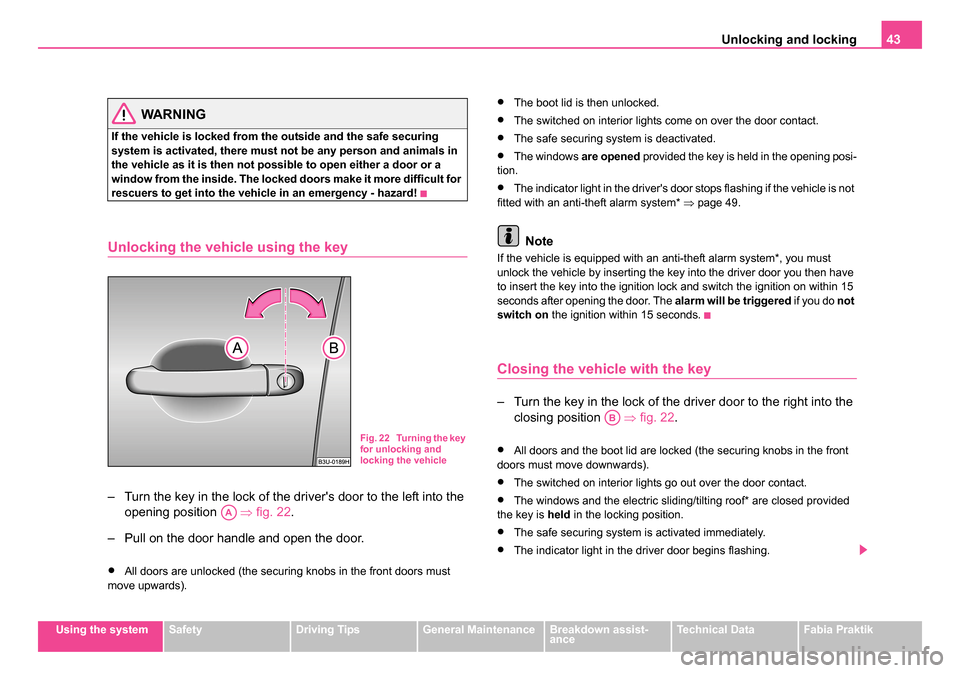
Unlocking and locking43
Using the systemSafetyDriving TipsGeneral MaintenanceBreakdown assist-
anceTechnical DataFabia Praktik
WARNING
If the vehicle is locked from the outside and the safe securing
system is activated, there must not be any person and animals in
the vehicle as it is then not poss ible to open either a door or a
window from the inside. The locked doors make it more difficult for
rescuers to get into the vehicle in an emergency - hazard!
Unlocking the vehicle using the key
– Turn the key in the lock of the driver's door to the left into the opening position ⇒fig. 22 .
– Pull on the door handle and open the door.
•All doors are unlocked (the securing knobs in the front doors must
move upwards).
•The boot lid is then unlocked.
•The switched on interior lights come on over the door contact.
•The safe securing system is deactivated.
•The windows are opened provided the key is held in the opening posi-
tion.
•The indicator light in the driver's door stops flashing if the vehicle is not
fitted with an anti-theft alarm system* ⇒page 49.
Note
If the vehicle is equipped with an anti-theft alarm system*, you must
unlock the vehicle by inserting the key into the driver door you then have
to insert the key into the ignition lock and switch the ignition on within 15
seconds after opening the door. The alarm will be triggered if you do not
switch on the ignition within 15 seconds.
Closing the vehicle with the key
– Turn the key in the lock of the driver door to the right into the
closing position ⇒fig. 22.
•All doors and the boot lid are locked (the securing knobs in the front
doors must move downwards).
•The switched on interior lights go out over the door contact.
•The windows and the electric sliding/tilting roof* are closed provided
the key is held in the locking position.
•The safe securing system is activated immediately.
•The indicator light in the driver door begins flashing.
Fig. 22 Turning the key
for unlocking and
locking the vehicle
AA
AB
sqc.1.book Seite 43 Mittwoch, 13. April 2005 1:09 13
Page 46 of 260
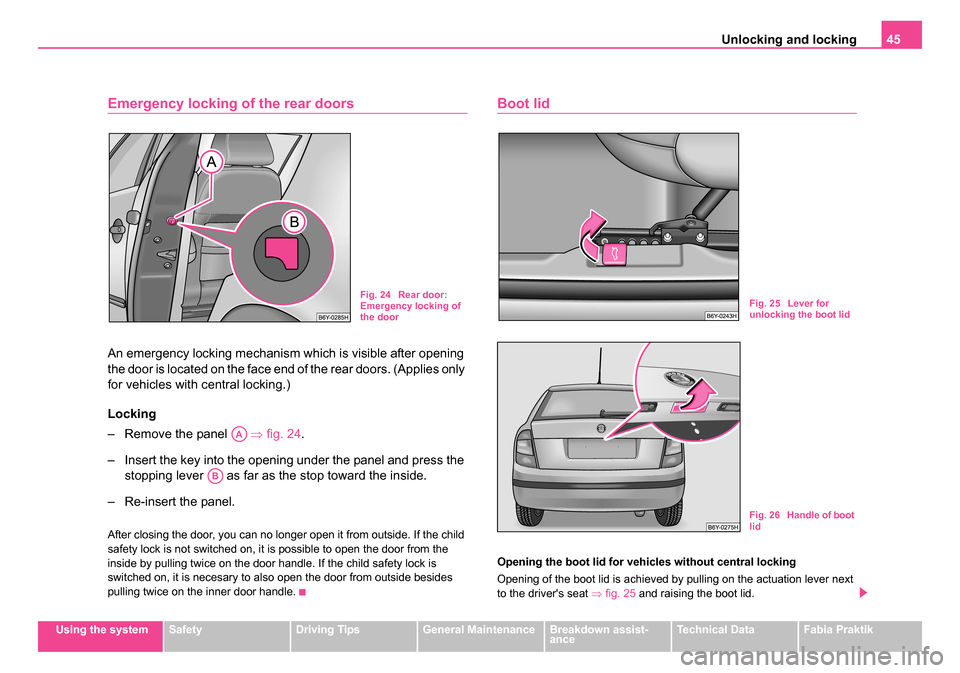
Unlocking and locking45
Using the systemSafetyDriving TipsGeneral MaintenanceBreakdown assist-
anceTechnical DataFabia Praktik
Emergency locking of the rear doors
An emergency locking mechanism which is visible after opening
the door is located on the face end of the rear doors. (Applies only
for vehicles with central locking.)
Locking
– Remove the panel ⇒fig. 24 .
– Insert the key into the opening under the panel and press the stopping lever as far as the stop toward the inside.
– Re-insert the panel.
After closing the door, you can no longer open it from outside. If the child
safety lock is not switched on, it is possible to open the door from the
inside by pulling twice on the door handle. If the child safety lock is
switched on, it is necesary to also open the door from outside besides
pulling twice on the inner door handle.
Boot lid
Opening the boot lid for vehicles without central locking
Opening of the boot lid is achieved by pulling on the actuation lever next
to the driver's seat ⇒fig. 25 and raising the boot lid.
Fig. 24 Rear door:
Emergency locking of
the door
AA
AB
Fig. 25 Lever for
unlocking the boot lid
Fig. 26 Handle of boot
lid
sqc.1.book Seite 45 Mittwoch, 13. April 2005 1:09 13
Page 48 of 260
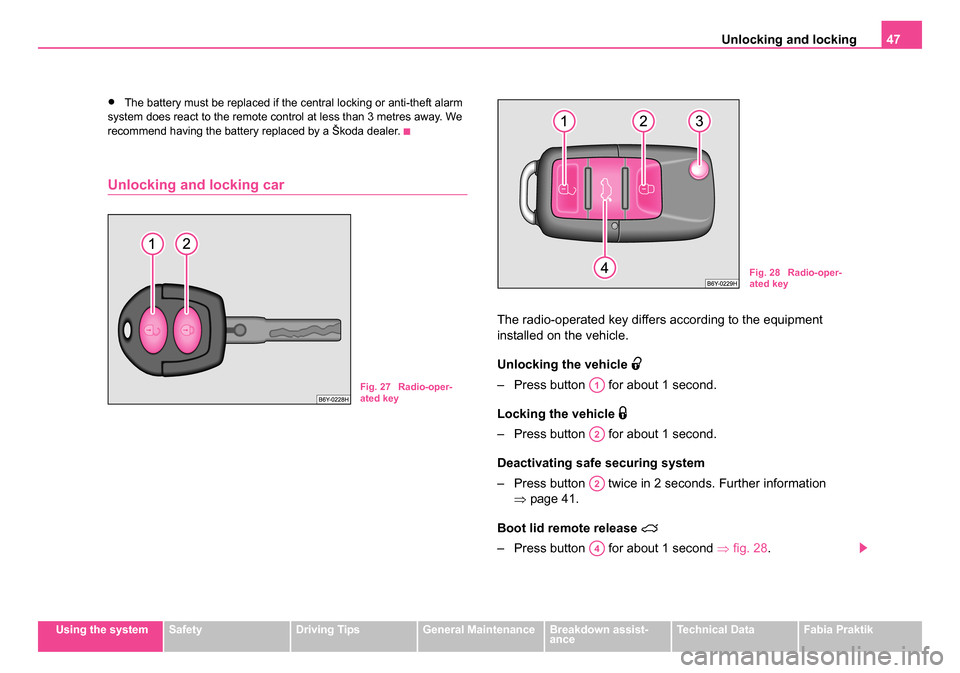
Unlocking and locking47
Using the systemSafetyDriving TipsGeneral MaintenanceBreakdown assist-
anceTechnical DataFabia Praktik
•The battery must be replaced if the central locking or anti-theft alarm
system does react to the remote control at less than 3 metres away. We
recommend having the battery replaced by a Škoda dealer.
Unlocking and locking car
The radio-operated key differs according to the equipment
installed on the vehicle.
Unlocking the vehicle
– Press button for about 1 second.
Locking the vehicle
– Press button for about 1 second.
Deactivating safe securing system
– Press button twice in 2 seconds. Further information ⇒page 41.
Boot lid remote release
– Press button for about 1 second ⇒fig. 28.
Fig. 27 Radio-oper-
ated key
Fig. 28 Radio-oper-
ated key
A1
A2
A2
A4
sqc.1.book Seite 47 Mittwoch, 13. April 2005 1:09 13
Page 50 of 260
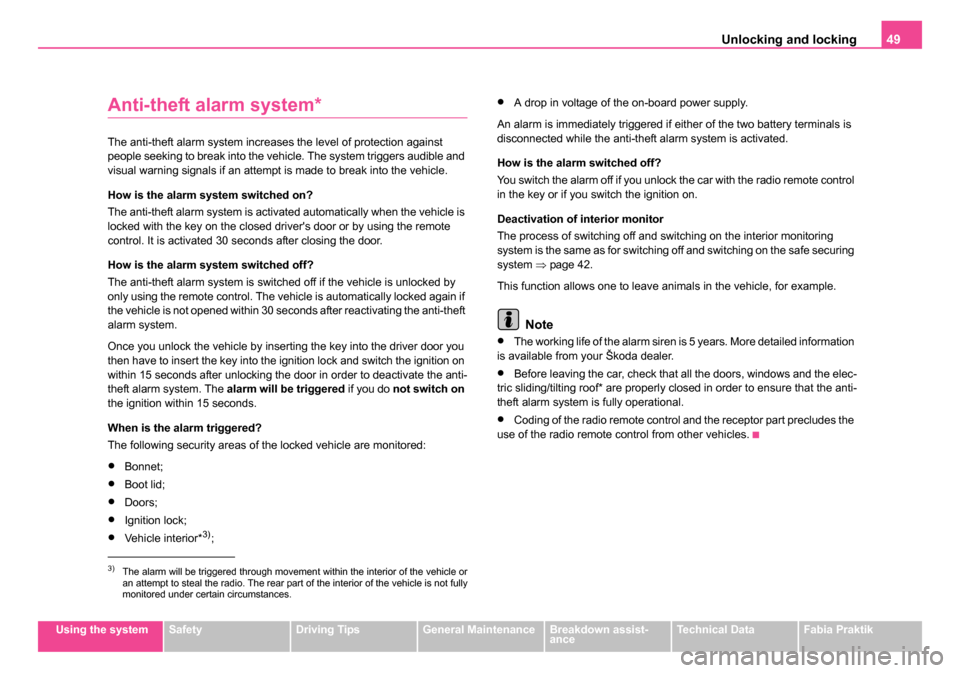
Unlocking and locking49
Using the systemSafetyDriving TipsGeneral MaintenanceBreakdown assist-
anceTechnical DataFabia Praktik
Anti-theft alarm system*
The anti-theft alarm system increases the level of protection against
people seeking to break into the vehicle. The system triggers audible and
visual warning signals if an attempt is made to break into the vehicle.
How is the alarm system switched on?
The anti-theft alarm system is activated automatically when the vehicle is
locked with the key on the closed driver's door or by using the remote
control. It is activated 30 seconds after closing the door.
How is the alarm system switched off?
The anti-theft alarm system is switched off if the vehicle is unlocked by
only using the remote control. The vehicle is automatically locked again if
the vehicle is not opened within 30 seconds after reactivating the anti-theft
alarm system.
Once you unlock the vehicle by inserting the key into the driver door you
then have to insert the key into the ignition lock and switch the ignition on
within 15 seconds after unlocking the door in order to deactivate the anti-
theft alarm system. The alarm will be triggered if you do not switch on
the ignition within 15 seconds.
When is the alarm triggered?
The following security areas of the locked vehicle are monitored:
•Bonnet;
•Boot lid;
•Doors;
•Ignition lock;
•Vehicle interior*3);
•A drop in voltage of the on-board power supply.
An alarm is immediately triggered if either of the two battery terminals is
disconnected while the anti-theft alarm system is activated.
How is the alarm switched off?
You switch the alarm off if you unlock the car with the radio remote control
in the key or if you switch the ignition on.
Deactivation of interior monitor
The process of switching off and switching on the interior monitoring
system is the same as for switching off and switching on the safe securing
system ⇒page 42.
This function allows one to leave animals in the vehicle, for example.
Note
•The working life of the alarm siren is 5 years. More detailed information
is available from your Škoda dealer.
•Before leaving the car, check that all the doors, windows and the elec-
tric sliding/tilting roof* are properly closed in order to ensure that the anti-
theft alarm system is fully operational.
•Coding of the radio remote control and the receptor part precludes the
use of the radio remote control from other vehicles.
3)The alarm will be triggered through movement within the interior of the vehicle or
an attempt to steal the radio. The rear part of the interior of the vehicle is not fully
monitored under certain circumstances.
sqc.1.book Seite 49 Mittwoch, 13. April 2005 1:09 13
Page 52 of 260

Unlocking and locking51
Using the systemSafetyDriving TipsGeneral MaintenanceBreakdown assist-
anceTechnical DataFabia Praktik
again. You should then take particular care when closing the
windows! A person may otherwise suffer severe injuries as a result
of getting an arm, for example, jammed in the window!
•It is recommended to deactivate the electrically operated power
windows in the rear doors (safety pushbutton) ⇒ page 50,
fig. 29 when children are being transported on the rear seats.
Note
•After switching the ignition off, it is still possible to open or close the
windows for a further 10 minutes. The automatic closing and opening
functions will not operate during this time. The power windows are
switched off completely once you open the driver or front passenger door.
•When driving, use the existing heating, air conditioning and ventilation
system for ventilating the interior of the vehicle. If the windows are
opened, dust and other dirt can get into the vehicle. The wind noise is
more at certain speeds.
Convenience operation of windows
You can open and close the electrically powered windows as
follows when unlocking and locking the vehicle (just closing of the
sliding roof).
Opening windows with the key
– Turn the key in the lock of the driver door into the opening position and hold it until all the windows are open. Closing windows with the key
– Turn the key in the lock of the driver door into the closing posi-
tion and hold it there until all of the windows are closed.
You can interrupt the opening or closing operation of the windows imme-
diately by releasing the key.
WARNING
•Obstruction protection is not active during the convenience
operating feature ⇒ in “Switch” on page 50.
•You should take particular care when closing the windows! A
person may otherwise suffer severe injuries as a result of getting
an arm, for example, jammed in the window!
Operational problems
Automatic closing or opening does not operate
If the battery of the car has been disconnected and then reconnected, the
automatic closing and opening function does not operate. The system
must be activated. Proceed as follows in order to re-establish the function:
•turn the key in the lock of the driver door into the closing position and
hold it there until all of the windows are closed,
•release the key,
•once again insert the key and turn it into the closing position for about
3 seconds.
Operation in winter
Ice accumulating on the surface of the windows during the winter may
result in a greater resistance when closing the windows and the window
may stop and move back several centimetres
WARNING (continued)
AS
sqc.1.book Seite 51 Mittwoch, 13. April 2005 1:09 13
Page 54 of 260

Unlocking and locking53
Using the systemSafetyDriving TipsGeneral MaintenanceBreakdown assist-
anceTechnical DataFabia Praktik
The wind noise in the comfort position is less than when the roof is fully
opened.
The sun screen is also opened automatically when the roof slides open.
You can slide the sun screen into the opened or closed position by hand
when the sliding/tilting roof is closed.
Caution
It may be necessary during winter to remove any ice and snow in the area
of the sliding/tilting roof before opening it in order to prevent damaging the
opening mechanism and the seal.
Closing
Sliding closed/closing the sliding/tilting roof
– Turn the switch to position
⇒page 52, fig. 30 .
Safety closing
The sliding/tilting roof is equipped with an overload protection system. The
sliding/tilting roof stops and moves back several centimetres when it
cannot be closed because there is something in the way (e.g. ice). You
can close the sliding/tilting roof completely without overload protection by
pressing the switch to the position ⇒page 52, fig. 30 at the front or
rear for as long as it takes for the sliding/tilting roof to shut completely
⇒ .
WARNING
Close the sliding/tilting roof carefully - risk of injury!
Convenience operation
You can also close an open sliding/tilting roof from the outside.
– Turn the key in the lock of the driver door into the closing posi-
tion and hold until the sliding/tilting roof is closed ⇒.
The closing process stops when one releases the key.
WARNING
Close the sliding/tilting roof carefully - risk of injury! The overload
protection system does not function with the convenience
closing.
Emergency operationAA
AA
Fig. 31 Detail of the
headliner: Emergency
operation
sqc.1.book Seite 53 Mittwoch, 13. April 2005 1:09 13
Page 56 of 260
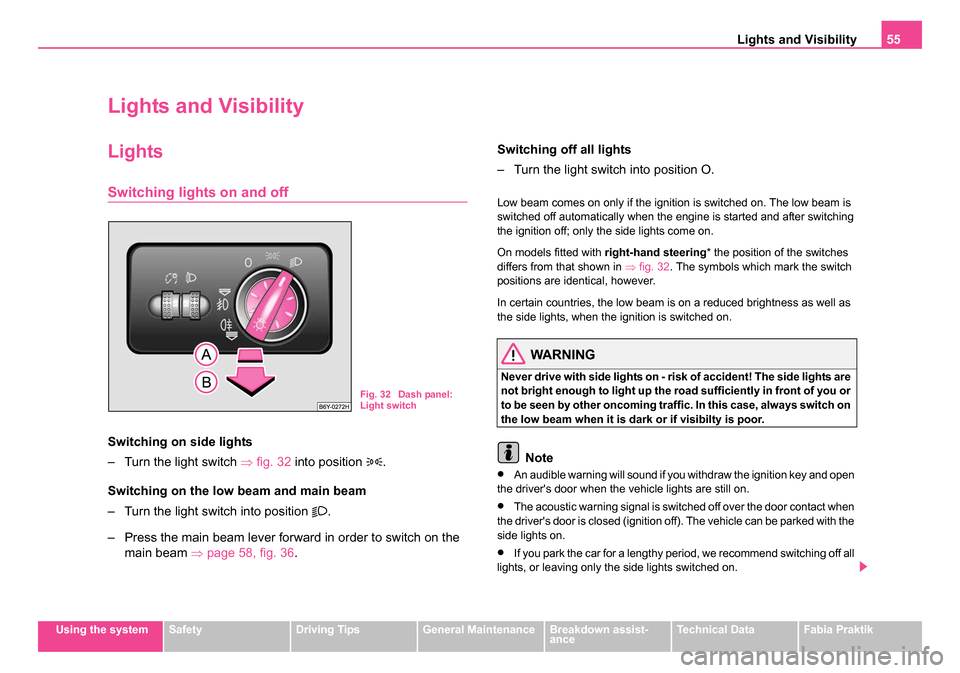
Lights and Visibility55
Using the systemSafetyDriving TipsGeneral MaintenanceBreakdown assist-
anceTechnical DataFabia Praktik
Lights and Visibility
Lights
Switching lights on and off
Switching on side lights
– Turn the light switch ⇒fig. 32 into position
.
Switching on the low beam and main beam
– Turn the light switch into position
.
– Press the main beam lever forward in order to switch on the main beam ⇒ page 58, fig. 36 . Switching off all lights
– Turn the light switch into position O.
Low beam comes on only if the ignition is switched on. The low beam is
switched off automatically when the engine is started and after switching
the ignition off; only the side lights come on.
On models fitted with
right-hand steering* the position of the switches
differs from that shown in ⇒fig. 32 . The symbols which mark the switch
positions are identical, however.
In certain countries, the low beam is on a reduced brightness as well as
the side lights, when the ignition is switched on.
WARNING
Never drive with side lights on - risk of accident! The side lights are
not bright enough to light up the road sufficiently in front of you or
to be seen by other oncoming traffic. In this case, always switch on
the low beam when it is dark or if visibilty is poor.
Note
•An audible warning will sound if you withdraw the ignition key and open
the driver's door when the vehicle lights are still on.
•The acoustic warning signal is switched off over the door contact when
the driver's door is closed (ignition off). The vehicle can be parked with the
side lights on.
•If you park the car for a lengthy period, we recommend switching off all
lights, or leaving only the side lights switched on.
Fig. 32 Dash panel:
Light switch
sqc.1.book Seite 55 Mittwoch, 13. April 2005 1:09 13
Page 58 of 260
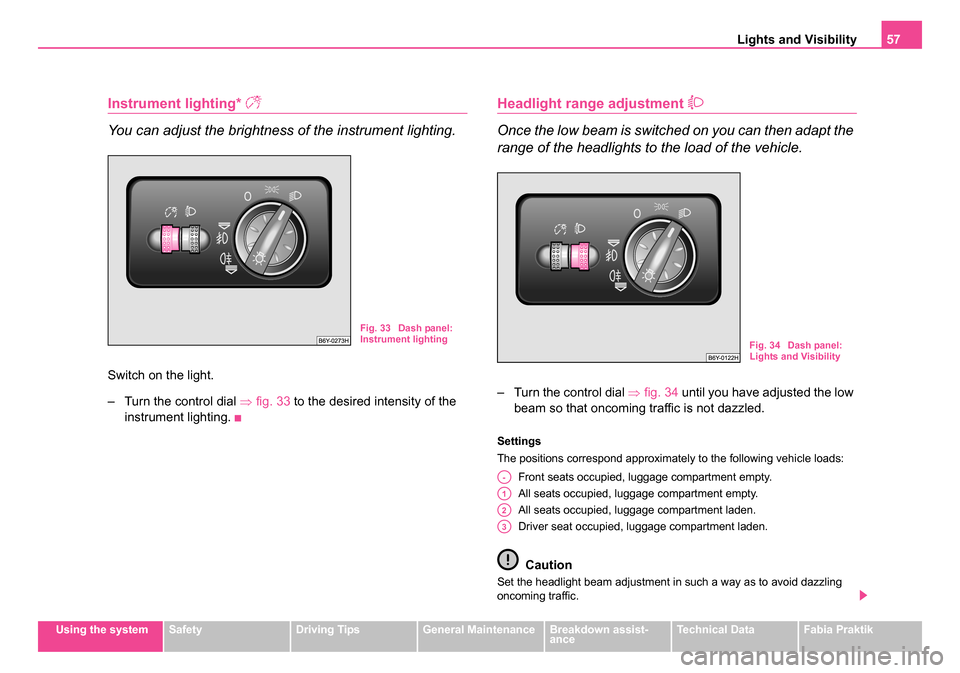
Lights and Visibility57
Using the systemSafetyDriving TipsGeneral MaintenanceBreakdown assist-
anceTechnical DataFabia Praktik
Instrument lighting*
You can adjust the brightness of the instrument lighting.
Switch on the light.
– Turn the control dial ⇒fig. 33 to the desired intensity of the
instrument lighting.
Headlight range adjustment
Once the low beam is switched on you can then adapt the
range of the headlights to the load of the vehicle.
– Turn the control dial ⇒fig. 34 until you have adjusted the low
beam so that oncoming traffic is not dazzled.
Settings
The positions correspond approximately to the following vehicle loads:
Front seats occupied, luggage compartment empty.
All seats occupied, luggage compartment empty.
All seats occupied, luggage compartment laden.
Driver seat occupied, luggage compartment laden.
Caution
Set the headlight beam adjustment in such a way as to avoid dazzling
oncoming traffic.
Fig. 33 Dash panel:
Instrument lighting
Fig. 34 Dash panel:
Lights and Visibility
A-
A1
A2
A3
sqc.1.book Seite 57 Mittwoch, 13. April 2005 1:09 13
Page 60 of 260
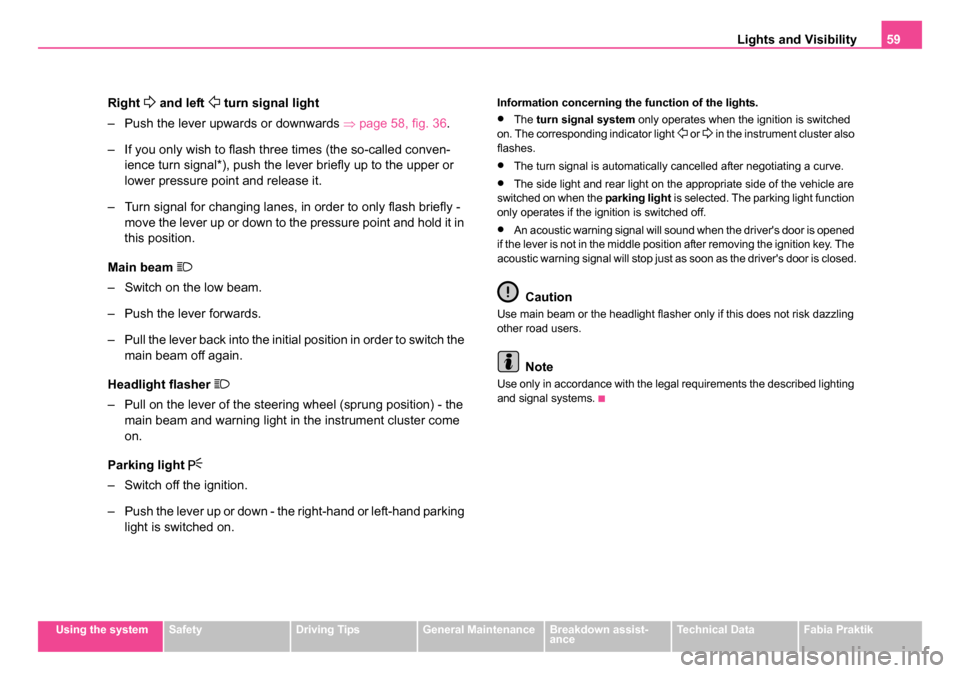
Lights and Visibility59
Using the systemSafetyDriving TipsGeneral MaintenanceBreakdown assist-
anceTechnical DataFabia Praktik
Right and left turn signal light
– Push the lever upwards or downwards ⇒page 58, fig. 36 .
– If you only wish to flash three times (the so-called conven- ience turn signal*), push the lever briefly up to the upper or
lower pressure point and release it.
– Turn signal for changing lanes, in order to only flash briefly - move the lever up or down to the pressure point and hold it in
this position.
Main beam
– Switch on the low beam.
– Push the lever forwards.
– Pull the lever back into the initial position in order to switch the main beam off again.
Headlight flasher
– Pull on the lever of the steering wheel (sprung position) - the main beam and warning light in the instrument cluster come
on.
Parking light
– Switch off the ignition.
– Push the lever up or down - the right-hand or left-hand parking light is switched on.
Information concerning the function of the lights.
•The turn signal system only operates when the ignition is switched
on. The corresponding indicator light or in the instrument cluster also
flashes.
•The turn signal is automatically cancelled after negotiating a curve.
•The side light and rear light on the appropriate side of the vehicle are
switched on when the parking light is selected. The parking light function
only operates if the ignition is switched off.
•An acoustic warning signal will sound when the driver's door is opened
if the lever is not in the middle position after removing the ignition key. The
acoustic warning signal will stop just as soon as the driver's door is closed.
Caution
Use main beam or the headlight flasher only if this does not risk dazzling
other road users.
Note
Use only in accordance with the legal requirements the described lighting
and signal systems.
sqc.1.book Seite 59 Mittwoch, 13. April 2005 1:09 13
Page 62 of 260
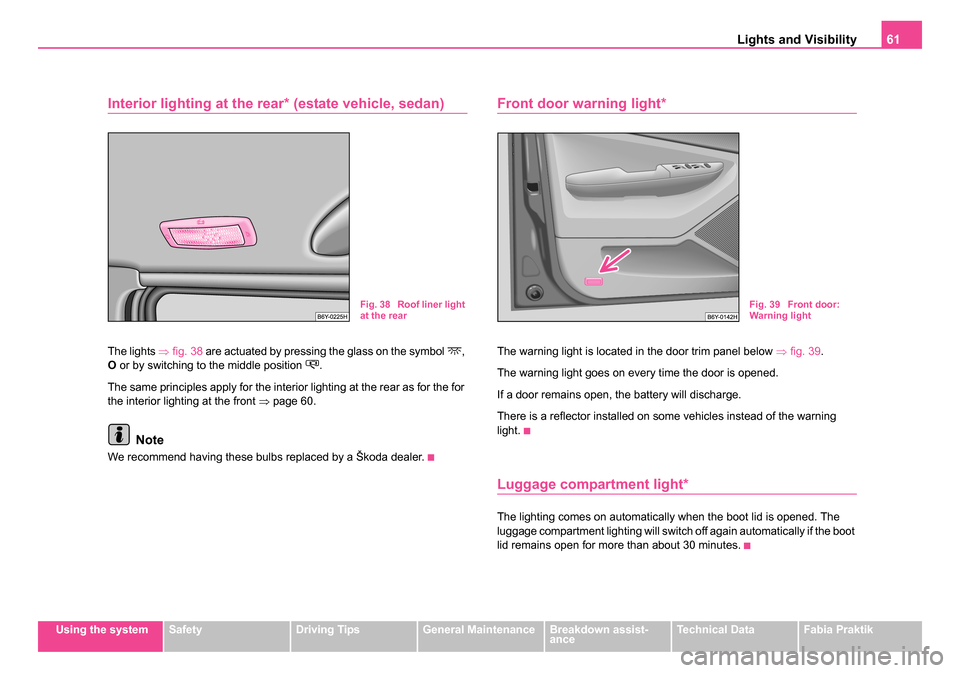
Lights and Visibility61
Using the systemSafetyDriving TipsGeneral MaintenanceBreakdown assist-
anceTechnical DataFabia Praktik
Interior lighting at the rear* (estate vehicle, sedan)
The lights ⇒fig. 38 are actuated by pressing the glass on the symbol ,
O or by switching to the middle position .
The same principles apply for the interior lighting at the rear as for the for
the interior lighting at the front ⇒page 60.
Note
We recommend having these bulbs replaced by a Škoda dealer.
Front door warning light*
The warning light is located in the door trim panel below ⇒fig. 39 .
The warning light goes on every time the door is opened.
If a door remains open, the battery will discharge.
There is a reflector installed on some vehicles instead of the warning
light.
Luggage compartment light*
The lighting comes on automatically when the boot lid is opened. The
luggage compartment lighting will switch off again automatically if the boot
lid remains open for more than about 30 minutes.
Fig. 38 Roof liner light
at the rearFig. 39 Front door:
Warning light
sqc.1.book Seite 61 Mittwoch, 13. April 2005 1:09 13